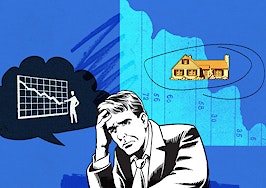In these times, double down — on your skills, on your knowledge, on you. Join us Aug. 8-10 at Inman Connect Las Vegas to lean into the shift and learn from the best. Get your ticket now for the best price.
Volatile mortgage rate increases have brought the housing market to a creep, as would-be homesellers desperately hold onto the savings they secured during 2020 and 2021’s historic interest rate drop. Since the federal government averted a disastrous June 2 debt default, rates have retreated to the mid-six-percent range — a drop that’s resulted in three consecutive weeks of increasing homebuyer mortgage demand.
So, what will it take to bring homesellers out of hiding and bring the housing market back to life? A five-percent mortgage rate, according to Compass CEO Robert Reffkin.

Robert Reffkin
“Across the board, there are more buyers than sellers,” Reffkin said during a CNBC appearance on Wednesday. “Buyers that have accepted six or seven percentage mortgage rates as a new normal. The issue that we have is there’s just not enough inventory, and that’s because 30 percent of homeowners are locked into mortgage rates at 3 percent or below, and 70 percent of homeowners are locked in a 4 percent or below.”
“We need to have an unlock [of] inventory. It’s probably going to happen when mortgage rates get to 5 to 5.5 percent in a sustainable level,” he added. “At that point, I would expect there to be a flood of inventory in the market. And we’ll feel like the pandemic craze all over again.”
Reffkin said some homebuyers are already bringing their rates down to the five-percent range through buydowns. There are two common ways to complete a buydown: paying a one-time discount point fee at closing to bring the rate down for the lifetime of the loan or using funds escrowed by the seller to temporarily drop the rate for the beginning of the loan.
“There are definitely incentives and buydowns bringing mortgage rates down by two points in a number of our markets,” he said.
While some homebuyers are waiting for the existing-home market to recover, Reffkin said a greater segment of homebuyers are simply turning their attention to the new-home market, which experienced a 20 percent year-over-year increase in May sales.
“[It’s a] great time to be a homebuilder because they’re benefiting from the price increases that are a result of low inventory,” he said. “Homebuilders are meeting [buyer] demand. Last month, we saw the largest amount of housing starts since 2016, and that’s because homebuilders, their sentiment index improved for the first time in over a year.”
Reffkin said it’ll likely be another year before rates drop to the five-percent range; however, the market could still experience a boost in existing-home inventory earlier as homeowners with adjustable-rate mortgages reevaluate the value of their current loans.
“The topic around adjustable rates, which I think people don’t fully appreciate, is that around 30 percent of the people that are locked in at three or four percent mortgage rates had adjustable rate mortgages that are five years, seven years or 10 years,” he said. “So the value of a 5-percent ARM they got in 2022, in six months is not that valuable anymore.”
The lock-in effect is the financial disincentive for existing homeowners to give up the low rate on their existing mortgage.
“You only have another year or year and a half” before ARM borrowers don’t feel locked in by the rate on their existing mortgage, he added. “So I think there’s going to be some new inventory entering the market, even if rates don’t come down because of those ARMs that are getting less value over time.”
Watch the full interview below:
Editor’s note: This story has been updated to correct that Reffkin said around 30 percent of the people that are “locked in” to mortgages at lower rates have ARM loans, rather than 30 percent were “wanting” mortgages at lower rates.













